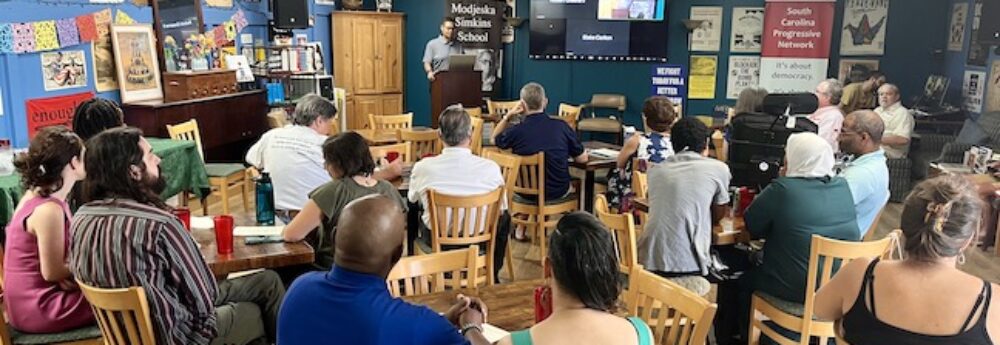Though few are paying attention now, the vote could impact November’s General Election.
by Jonathan Nack
San Francisco Bay Area Independent Media Center
Ignored by the corporate media, and derided by even many of their progressive and left-wing friends, registrants of California’s two leftist ballot eligible parties will also be voting in tomorrow’s Presidential primary in California. The decision these voters make will have implications on the General Election in November.
While blacked out of establishment mass media coverage, the California Green Party and Peace and Freedom Party primaries are stories of note and import. Former Congresswoman Cynthia McKinney, and perennial candidate Ralph Nader headline fields of candidates on the ballots for both parties. In addition to these two nationally known leaders, lesser-known candidates include Bay Area socialist leader Gloria La Riva, who is competing for the Peace and Freedom Party nomination. Interested readers can check out all the candidate statements on line.
Cynthia McKinney is a rare example of a long-time Democratic Party politician, who served six terms in Congress, and who jumped from the Democrats to the Greens late last year. In abandoning hope in the Democrats, she’s embraced the Green Party as building an alternative. She’s since campaigned in 21 states, frequently appearing with Green Party candidates for local office.
McKinney is a seasoned and skilled politician, well versed on the issues, articulate, and courageously outspoken. An African American, who spent twelve years in Congress representing one of the poorest districts in the country, McKinney has the potential to get a hearing beyond the mainly White audiences whom generally receive the Green Party message.
Ralph Nader announced last week that he was forming an exploratory committee, so he’s not even committed to running yet. While it’s quite late in the primary season to begin exploring a candidacy, Nader’s name recognition, his unwavering anti-corporate message, his considerable network of supporters, and his past ability to run campaigns in all fifty states, make him an instant player.
Nader has said that if he runs, it will be as an independent, but he will seek the nomination of the Green Party, and other small left parties which have ballot lines in some states. In most states, he’d petition to make the November ballot as an independent.
The story of how both McKinney and Nader each came to be on both the Green Party and Peace and Freedom Party ballots has yet to be told. It’s part of the story of how the U. S. left continues to search for relevance in elections. Each had enough support in each party to be nominated. Nader wasn’t even officially exploring a candidacy at the time he was nominated. McKinney was nominated as a Peace and Freedom candidate, even though she has publicly registered as a Green.
McKinney and Nader haven’t debated, so it’s difficult to tease out differences between them. They share many positions in common which distinguish them from the Democratic and Republican candidates. Both have taken strong stances against the U. S. wars in Iraq and Afghanistan, and call for greatly reducing the military budget. Both are for Single Payer health care. Both have an anti-corporate message and are strong voices of dissent. Both have spent their lives in support of grassroots movements for social and environmental justice.
Nader’s power lies in his unflinching analysis of corporate domination and how it impacts our lives and his steadfast commitment to real democracy. McKinney, while sharing much of Nader’s analysis, would undoubtedly put more emphasis on issues of racial justice than Nader. McKinney and also offers a level of political skills and charisma than Nader has demonstrated.
One issue that surely looms for the General Election, is how Nader and McKinney will handle their campaigns in the states which will be hotly contested between the Democrats and Republicans. Nader’s history on the issue is well known and controversial, even among leftists. Nader has downplayed the issue and stated that there are forty states that won’t be closely contested, so people can vote their conscience in those states. In the past, he has campaigned in every state, regardless. He’s also offered the option of “vote swapping” – in which someone who wanted to vote for him but was is a “swing state” could swap votes with someone who would vote for Democrat in a state that is sure to go Republican. That idea has yet to catch on.
McKinney hasn’t articulated an approach this political hot potato for the left. A number of Green Party insiders think McKinney’s approach would differ from Nader’s. Given the Green Party’s weakened status following the 2004 elections, when a relative unknown, David Cobb, was nominated by the Party and it received much fewer votes, it’s not clear how many states McKinney will be able to get on the ballot in.
California, where the Democrats are favored and have easily won in recent Presidential elections, doesn’t figure to be one of the swing states in 2008.
Less than 1.2 percent of California’s registered voters will get to decide between McKinney and Nader. There are 127,042 registered as Green Party and 57,224 registered as Peace and Freedom Party, according to the California Secretary of State. They’re the only voters eligible to decide whether it will be McKinney or Nader, or perhaps both, who will appear on the ballot in California in November. Progressives and leftists engaged in the Democratic Party primary now, will certainly be taking note then.
